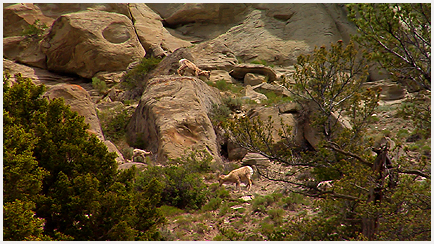Â
Bighorn sheep (Ovis canadensis) once numbered in the millions in western United States and were an important food source for humans. The “Sheepeaters”, related to the Shoshoni tribe, lived year-round in Yellowstone until 1880. Their principal food was bighorn sheep and they made their bows from sheep horns. By 1900, during an “epoch of relentless destruction by the skin hunters” (Seton 1913), bighorn numbers were reduced to a few hundred in the United States. In 1897 Seton spent several months roaming the upper ranges of Yellowstone Park and did not see any, although about 100-150 were estimated to be present. He reported that by 1912, despite a disease (scab) contracted from domestic sheep, bighorns in the park had increased to more than 200 and travelers could find them with fair certainty by devoting a few days to searching around Mt. Everts, Mt. Washburn or other well-known ranges. In winter, small bands of sheep could then be seen every day between Mammoth and Gardiner …”4 great rams with about 40 other sheep…so tame that one could get pictures within ten feet…”
Bighorn sheep are named for the large, curved horns borne by the males, or rams. Females, or ewes, also have horns, but they are short with only a slight curvature. Sheep range in color from light brown to grayish or dark, chocolate brown, with a white rump and lining on the back of all four legs. Rocky Mountain bighorn females weigh up to 200 pounds, and males occasionally exceed 300 pounds. During the mating season or “rut”, occurring in November and December, the rams butt heads in apparent sparring for females. Rams’ horns can weigh more than 40 pounds, and frequently show broken or “broomed” tips from repeated clashes. Lambs, usually only one per mother, are born in May and June. They graze on grasses and browse shrubby plants, particularly in fall and winter, and seek minerals at natural salt licks. Bighorns are well adapted to climbing steep terrain where they seek cover from predators such as coyotes, eagles, and mountain lions. They are susceptible to disease such as lungworm, and sometimes fall off cliffs.
 Follow
Follow






Speak Your Mind